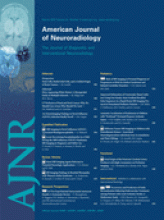Abstract
SUMMARY: MR imaging manifestations of influenza A−associated encephalitis have been described previously. However, there is very limited information about the central nervous system complications of the novel influenza A(H1N1) virus. MR imaging findings of novel influenza A−associated meningoencephalitis in a child are presented.
Abbreviations
- ADC
- apparent diffusion coefficient
- FFE
- fast-field echo
- WHO
- World Health Organization
Since the first report of novel influenza A(H1N1) virus in Mexico in April 2009,1 a rapid spread to many countries around the world has occurred. In June 2009, the WHO raised the alert level to phase 6 (pandemic phase) on the basis of documented human-to-human spread of infection in at least 3 countries in 2 WHO regions.
Awareness of imaging features of the disease and imminent complications of the virus is important. MR imaging findings of encephalitis associated with influenza A virus have been described previously.2–5 However, to my knowledge, there are very limited reports about H1N1 virus−associated central nervous system lesions. Lyon et al6 presented radiologic findings of acute necrotizing encephalopathy in a child with H1N1 influenza infection. I present conventional and diffusion MR imaging findings of H1N1-associated meningoencephalitis in a child.
Case Report
A previously healthy 3-year-old girl presented to our emergency department with high fever (39°C) and focal convulsion. Her routine immunizations were up-to-date. She did not receive the seasonal influenza or H1N1 vaccine. The following day she experienced focal convulsions and lost consciousness. The girl was given anticonvulsive and antiviral (acyclovir) medication; however, no acute improvement was noticed. Lumbar puncture showed a normal biochemical structure of the CSF. Contrast-enhanced MR imaging was performed for suspected encephalitis and complications. Antiviral therapy for H1N1 (oseltamivir) was administered after the nasopharyngeal swabs confirmed H1N1 virus infection.
MR imaging demonstrated bilateral perirolandic T2 hyperintensities with restricted diffusion and round T2 hyperintense lesions in both thalami (Fig 1). Following intravenous contrast agent administration, diffuse meningeal enhancement was seen in both cerebral hemispheres. Enhancement was more pronounced in the right perirolandic area (Fig 2). T2 hyperintensity was more prominent in the right perirolandic area as well, along with magnetic susceptibility on T2 FFE images (Fig 3). There was no sign of cerebral edema.
T2-weighted transverse MR images demonstrate bilateral thalamic (upper right) and perirolandic (upper left) hyperintensities with restricted diffusion in the isotropic b = 1000 image (lower right) and the ADC map (lower left).
Contrast-enhanced transverse T1-weighted images show diffuse meningeal enhancement in both cerebral hemispheres, which is more pronounced in the right perirolandic area.
Magnetic susceptibility on a T2 FFE image in the right perirolandic area.
On the fifth hospital day, she recovered consciousness, and oral nourishment was begun.
Discussion
Association of influenza virus infection with central nervous system lesions was reported previously and named “influenza-associated encephalitis/encephalopathy.”7 The beginning of neurologic symptoms is usually within a few days to a week after the first signs of influenza A infection, and complete recovery occurs within a month.4 Symmetric splenial lesions (restricted diffusion and T2 hyperintensities) of the corpus callosum have been frequently reported in these patients.3,4,8 In addition, symmetric localized hypoattenuated lesions within the thalami and pons on CT and ringlike areas of high signal intensity in the pons on MR imaging were reported.2
Lyon et al6 reported CT and MR imaging findings in a 12-year-old girl infected with influenza A(H1N1) whose clinical course was complicated by acute necrotizing encephalopathy. The authors reported T2 hyperintensity and restricted diffusion in the thalami, cerebellar hemispheres, brain stem, and centrum semiovale bilaterally; enlarged heterogeneous thalami with ring-enhancing lesions; and abnormal enhancement in the centrum semiovale and brain stem. In addition, magnetic susceptibility in the bilateral thalamus was demonstrated in T2* gradient-recalled echo images. CT showed diffuse hypoattenuation in the thalamus and brain stem with sulcal effacement and brain stem edema. Lyon et al did not report any meningeal abnormality. In my case, bilateral thalamic T2 hyperintensities seem similar to the findings of Lyon et al. I observed magnetic susceptibility artifacts, too; however, they were in the right perirolandic area, not in the thalami. Also, bilateral perirolandic changes and diffuse meningeal enhancement are the differential imaging characteristics of this case.
Kimura et al5 divided influenza-related brain changes into 5 categories based on the MR imaging and CT findings: normal (category 1), diffuse involvement of the cerebral cortex (category 2), diffuse brain edema (category 3), symmetric involvement of the thalamus (category 4), and postinfectious focal encephalitis (category 5). Because of the bilateral thalamic lesions, my case may be classified as category 4; however, accompanying meningeal and perirolandic changes do not appear to be simply categorized. These varied findings can be explained by the unknown pathogenesis of brain lesions associated with influenza infection. Alternatively, the novelty of the influenza A(H1N1) virus infection may have caused these changes.
To the best of my knowledge, MR imaging findings of novel influenza A(H1N1) meningoencephalitis have not been reported before. In this regard, this report is the first in the literature. H1N1 encephalitis should be added to the differential diagnosis of bilateral lesions in the thalami and perirolandic area with meningeal enhancement. Neuroradiologists should be aware of this entity and its MR imaging manifestations, particularly during the pandemic phase.
Indicates open access to non-subscribers at www.ajnr.org
References
- Received January 4, 2010.
- Accepted after revision January 7, 2010.
- Copyright © American Society of Neuroradiology















